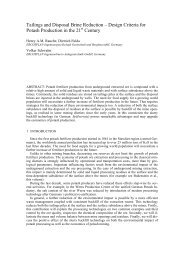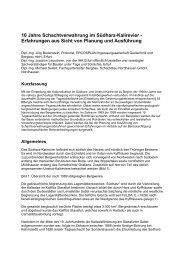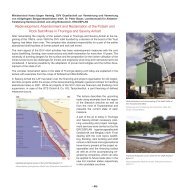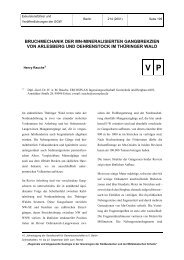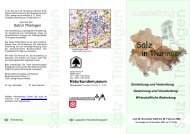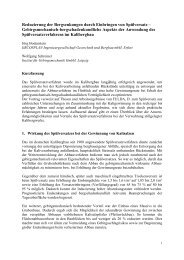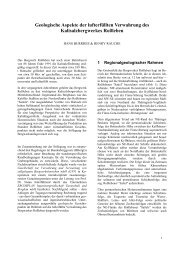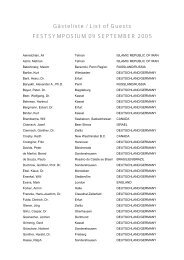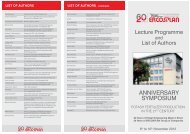Happy birthday, ERCOSPLAN - Ercosplan.com
Happy birthday, ERCOSPLAN - Ercosplan.com
Happy birthday, ERCOSPLAN - Ercosplan.com
Create successful ePaper yourself
Turn your PDF publications into a flip-book with our unique Google optimized e-Paper software.
The university city of Erfurt is the<br />
capital of Thuringia – the Green<br />
Heart of Germany, and a region<br />
famed for thinkers and poets down the<br />
centuries. It is also the headquarters of<br />
the <strong>ERCOSPLAN</strong> Group of <strong>com</strong>panies,<br />
which celebrated its 50th anniversary in<br />
some style of 9 September 2005 in an<br />
Honour Symposium that was attended<br />
by 120 guests from nine countries.<br />
Thuringia and the adjacent states of<br />
Hesse and Saxony-Anhalt have access to a<br />
wide range of mineral ores and salts, and<br />
the region became a centre of mining in<br />
Germany in medieval times. At one time,<br />
the number of mines exceeded 3,000.<br />
Only a handful remain today, but they<br />
are of world-ranking significance, as they<br />
<strong>com</strong>prise the network of potash mines<br />
and processing plants operated by K+S<br />
Kali GmbH (K+S).<br />
Potash is at the heart of the ERCOS-<br />
PLAN business portfolio. As the successor<br />
to the former Kali-Ingenieurbüro<br />
Erfurt, <strong>ERCOSPLAN</strong> is a specialist consulting<br />
and engineering group whose<br />
core activities include project management<br />
in all aspects of the extraction and<br />
processing of industrial potash and mineral<br />
salts. <strong>ERCOSPLAN</strong> enjoys unique<br />
expertise in the following fields:<br />
◆ Exploration and evaluation of mineral<br />
salts and natural brine deposits.<br />
◆ Conventional and solution mining of<br />
<strong>Happy</strong> <strong>birthday</strong>,<br />
<strong>ERCOSPLAN</strong><br />
mineral salt deposits and natural brines.<br />
◆ Processing of mineral salts and natural<br />
brines.<br />
◆ Environmental sustainability in modern<br />
mines and processing plants.<br />
The <strong>ERCOSPLAN</strong> Group consists of<br />
six associated <strong>com</strong>panies. As inheritors of<br />
the tradition set by Kali-Ingenieurbüro,<br />
they offer consulting and planning services<br />
for the exploration, mining and processing<br />
of potash and other mineral salts, including<br />
environmental conservation and rehabilitation,<br />
as well as ensuring the effective<br />
utilisation of resources. Now a limited liability<br />
<strong>com</strong>pany whose shares are owned by<br />
the management, employees and other<br />
POTASH<br />
The <strong>ERCOSPLAN</strong> Group of <strong>com</strong>panies celebrated its 50th <strong>birthday</strong> in some style in<br />
its home cityof Erfurt, Germany.As well as being a renowned university city, Erfurt is close to Germany’s<br />
potash heartland – the field in which <strong>ERCOSPLAN</strong> and its predecessors gained a core<br />
expertise as a mining consulting and engineering group.As described here,<br />
the celebrations attracted participants from far afield.<br />
The mining and processing of potash is at the<br />
heart of the <strong>ERCOSPLAN</strong> business portfolio.<br />
long-term partners, <strong>ERCOSPLAN</strong> is entirely<br />
independent from other mineral salt<br />
producers and equipment suppliers. In<br />
this, its Golden Jubilee year, ERCOS-<br />
PLAN today employs around 125 specialist<br />
staff, 75 of them in Erfurt, with others<br />
in branch offices in Leipzig and Sondershausen.<br />
As a reflection of the Group’s confidence<br />
in its future, it also employs around<br />
nine apprentices.<br />
All associated with the Group are<br />
proud of <strong>ERCOSPLAN</strong>’s achievements<br />
and look forward to a very bright future,<br />
especially as the Group continues to<br />
accumulate its expertise when providing<br />
the following services:<br />
◆ Pre-feasibility studies, feasibility studies,<br />
bankable feasibility studies and due<br />
diligence studies for <strong>com</strong>plete potash<br />
and mineral salt projects.<br />
◆ Exploration concept studies, estimations<br />
of geological resources and mineable<br />
reserves.<br />
◆ Basic engineering and detail engineering<br />
for <strong>com</strong>plete potash and mineral salt<br />
projects, from mineral extraction to<br />
final product shipping.<br />
◆ Process design and technology.<br />
◆ Investment studies, capital cost assessment<br />
studies and operating cost analyses.<br />
◆ Environmental impact assessment<br />
studies.<br />
◆ Market studies.<br />
◆ Project management and control.<br />
FERTILIZER INTERNATIONAL NO. 409 NOVEMBER/DECEMBER 2005 39
POTASH<br />
◆ Supervision of installation, <strong>com</strong>missioning<br />
and start-up.<br />
◆ Mine abandonment and closure, plant<br />
demolition engineering.<br />
Exploiting the<br />
White Gold<br />
Central Germany is the cradle of the modern<br />
international potash industry, exploiting<br />
the famous “White Gold”. Almost<br />
150 years ago, the first potash production<br />
began in Stassfurt, in the North Harz<br />
region. During drilling exploration for<br />
rock salt, carnallite brines were discovered<br />
in 1851, below which thick rock salt layers<br />
were found. Ten years later, the carnallite<br />
began to be processed, using a cold leaching<br />
technology that was developed locally.<br />
By the end of the 19th century, more than<br />
50 mines and plants had been set up in the<br />
Stassfurt area alone. Hot leaching technology<br />
was first harnessed in 1898 at<br />
Sondershausen, South Harz. These were<br />
the roots of the body of knowledge that<br />
forms the core of <strong>ERCOSPLAN</strong> Group<br />
today.<br />
When Germany was divided between<br />
the Federal Republic and German Democratic<br />
Republic (GDR), the latter became<br />
the third largest producer of potash worldwide<br />
and under state control, Kali-<br />
Ingenieurbüro became responsible for<br />
planning projects. A significant landmark<br />
was the opening of the Zielitz plant in<br />
1972, north of Magdeburg, to exploit<br />
the sylvinite deposit. Zielitz became part<br />
of K+S Kali GmbH in the early 1990s,<br />
and a <strong>com</strong>prehensive modernisation programme<br />
established Zielitz as the most<br />
modern potash facility in Europe, producing<br />
more than 40,000t/d ore. Production<br />
is expected to break all records in 2005,<br />
exceeding 1.5 million tonnes K 2O.<br />
<strong>ERCOSPLAN</strong> has done remarkably<br />
well to cope with the political, economic<br />
and social upheavals that followed German<br />
reunification in 1990. Many formerly<br />
state-owned enterprises have fallen<br />
by the wayside during the subsequent<br />
period, unable to cope with the new market<br />
environment. By contrast, ERCOS-<br />
PLAN had the vision to draw on its<br />
expertise and traditions and regenerate<br />
itself as a leading supplier of engineering<br />
and advisory services to the German<br />
From Kali-Ingenieurbüro to <strong>ERCOSPLAN</strong>: the major milestones<br />
1948-1955: The beginnings<br />
This was a period of reconstruction after the devastation of World War II.<br />
Damaged and abandoned potash mines and processing plants were repaired and<br />
re<strong>com</strong>missioned, under the administration of the Soviet Union.<br />
1955-1969: The Kali-Ingenieurbüro era is launched<br />
A specialist group of engineers was brought together and a dedicated office built<br />
in Erfurt, employing up to 230 staff. Potash mining and processing was vested<br />
with the state-owned Vereinigung Volkseigener Betriebe Kali, within which<br />
Kali-Ingenieurbüro (KIB) operated independently. Extensive investments were<br />
made during this period in the Southern Harz facilities of Bernburg and Zielitz.<br />
1970-1990: The Kombinat Kali era<br />
The government’s reorganisation of the Thuringian and South Harz potash<br />
industry resulted in the formation of the Kombinat Kali, which exercised more<br />
centralised control. KIB lost its autonomy as a consequence. One outstanding<br />
achievement during this period was the planning, development and <strong>com</strong>missioning<br />
of the potash plant at Zielitz, together with major investments at the<br />
Merkers, Sondershausen, Teutschenthal and Bleicherode plants.<br />
1990-1992: German reunification and KIB Plan GmbH<br />
German reunification in October 1990 was ac<strong>com</strong>panied by massive political,<br />
economic and social changes in the former GDR states, which impacted on the<br />
potash industry. The first two years were a period of transition as Kali-<br />
Ingenieurbüro was reorganised as KIB Plan GmbH and its parent <strong>com</strong>pany<br />
adapted to the new market-based economy and prepared for privatisation.<br />
1992-1995: Enter <strong>ERCOSPLAN</strong> GmbH<br />
<strong>ERCOSPLAN</strong> GmbH was formed in July 1992 when 11 partners from KIB<br />
joined forces to exercise a management buy-out (MBO). The official name of the<br />
new <strong>com</strong>pany indicated its intended line of business: <strong>ERCOSPLAN</strong> Erfurter<br />
Consulting und Planungsbüro GmbH. The new team quickly gained an impressive<br />
portfolio of clients in Thuringia, Saxony-Anhalt and Hesse. Further expansion<br />
followed with the acquisitions of Institut für Gebirgsmechanik GmbH (IfG),<br />
Leipzig in 1992, and Glückauf Vermessung GmbH, Sondershausen in the following<br />
year. However, an economic downturn in 1995 put <strong>ERCOSPLAN</strong> GmbH<br />
under considerable financial pressure, and the <strong>com</strong>pany undertook a major review<br />
of its activities and structure, which led to a fundamental reorganisation.<br />
1996-2005: The <strong>ERCOSPLAN</strong> Group of Companies<br />
To secure the long-term future for the group, individual business areas were<br />
gradually transformed into four new single private limited liability <strong>com</strong>panies<br />
under one holding, supplemented by the Institut für Gebirgsmechanik (IfG)<br />
and Glückauf Vermessung subsidiaries, which have retained their identity. The<br />
<strong>ERCOSPLAN</strong> Umwelt Consulting GmbH subsidiary was the first to emerge,<br />
in 1996, followed by <strong>ERCOSPLAN</strong> Ingenieurgesellschaft Geotechnik und<br />
Bergbau mbH and <strong>ERCOSPLAN</strong> Ingenieurbüro Anlagentechnik GmbH in<br />
1998, and <strong>ERCOSPLAN</strong> Hoch- under Tiefplanung GmbH in 2001.<br />
<strong>ERCOSPLAN</strong> Ingenieurgesellschaft Geotechnik und Bergbau GmbH and<br />
<strong>ERCOSPLAN</strong> Ingenieurbüro Anlagentechnik GmbH continue the KIB traditions<br />
in the field of mineral salt mining. The client portfolio is now a global one.<br />
Despite being the youngest of the four subsidiaries, <strong>ERCOSPLAN</strong> Hoch- und<br />
Tiefbauplanung Gmbh has enjoyed considerable success to earn the highest<br />
share of the group’s turnover, which totalled around i10 million in 2004.<br />
40 FERTILIZER INTERNATIONAL NO. 409 NOVEMBER/DECEMBER 2005
POTASH<br />
Headquarters of the <strong>ERCOSPLAN</strong> Group of <strong>com</strong>panies in Erfurt.<br />
potash industry and increasingly to a<br />
global list of clients.<br />
<strong>ERCOSPLAN</strong> recognises that the<br />
exploration and evaluation of mineral salt<br />
resources are multi-stage processes. The<br />
valuable salt may be contained in an<br />
underground deposit or as natural brine<br />
in the pore volume of rocks, or in lakes<br />
on the earth’s surface. With each step,<br />
knowledge of the deposit increases, but<br />
the exploration costs increase even further.<br />
A decision therefore has to be made<br />
at each stage whether or not there is a reasonable<br />
chance that the raw material can<br />
be exploited and processed economically.<br />
This requires firstly an interpretation of<br />
the available exploration data by experienced<br />
geoscientists. It furthermore needs<br />
an understanding of the extraction and<br />
processing technology from the outset.<br />
A 3-D model of the proposed IMPASCO potash plant near Khor, Iran.<br />
At this stage in the project, ERCOS-<br />
PLAN geologists, mining and drilling<br />
engineers will liaise with the Group’s<br />
process designers and processing engineers<br />
to carry out a realistic assessment of<br />
the geological resources and the mineable<br />
reserves. The service will typically begin<br />
with a critical examination of all available<br />
data about the deposit, which are then<br />
used to develop a geologic 3D model of<br />
the deposit as a basis for exploring concepts.<br />
Geological fieldwork, core logging,<br />
sampling and drilling supervision are<br />
included in the scope of the study.<br />
The next stage in the project is to evaluate<br />
the rock mechanics. Mineral extraction<br />
from an underground deposit will create<br />
mine openings whose safety and stability<br />
must be guaranteed during the whole<br />
mine life and furthermore after the closure<br />
date. Rock mechanical studies are thus an<br />
important aspect of mine design and<br />
extraction schedules, as well as for environmentally<br />
safe mine closure procedures.<br />
The Institute für Gebirgsmechanik<br />
GmbH subsidiary specialises in mechanical<br />
studies, offering:<br />
◆ Rock mechanical laboratory test work<br />
◆ Rock mechanical in situ test work<br />
◆ Rock mechanical modelling.<br />
The Institut für Gebirgsmechanik<br />
GmbH employs state-of-the-art technology<br />
to provide <strong>com</strong>putational modelling<br />
of rock mechanical behaviour. The programs<br />
developed by the Institut für<br />
Gebirgsmechanik include:<br />
◆ An elasto-plastic material model to<br />
describe the softening and brittle facture<br />
of carnallite.<br />
◆ A visco-elastoplastic material model<br />
with softening, dilatancy and primary,<br />
secondary and tertiary creep to describe<br />
the time-dependent softening behaviour<br />
of salt rocks preceding creep fracture.<br />
◆ A <strong>com</strong>bined material model for describing<br />
the creep of salt rocks, including<br />
inverse transient creep.<br />
The MKEN and SENK programs for<br />
<strong>com</strong>puting time-dependent stress-strain<br />
processes in underground mining systems<br />
and for predicting the surface effects<br />
resulting from mine subsidence.<br />
By harnessing these tools, all issues<br />
arising from underground mineral extractions<br />
and/or disposal and storage in underground<br />
openings can be evaluated.<br />
All aspects of mining<br />
Since every mineral deposit is unique, it<br />
requires a particular mine layout and<br />
adaptation of proven exploitation methods<br />
as well as the careful selection of subsurface<br />
infrastructure systems before starting<br />
a mining project. Inclination, spatial<br />
distribution of areas with different thicknesses<br />
and grades influence the efficiency<br />
of conventional mining, and thus an optimised<br />
mine layout is a key element in<br />
overall efficiency when extracting the ore.<br />
The <strong>ERCOSPLAN</strong> Group provides<br />
consulting and planning services to support<br />
the client at all stages of the mining<br />
project:<br />
◆ Beginning with the first concepts for the<br />
new operation.<br />
42 FERTILIZER INTERNATIONAL NO. 409 NOVEMBER/DECEMBER 2005
◆ Followed by design and method studies<br />
for debottlenecking and/or extending<br />
running operations.<br />
◆ Up to the mine closure and site reclamation.<br />
Starting with the mine layout and mining<br />
method engineering, both tailored to<br />
take account of the deposit’s particular<br />
geology as well as the hydrogeological and<br />
rock mechanical limitations of underground<br />
extraction, <strong>ERCOSPLAN</strong>’s consultants<br />
will design a mine that is optimised<br />
for maximum production capacity<br />
and minimal operating costs.<br />
<strong>ERCOSPLAN</strong> pays particular attention<br />
to mine safety concepts, based on a<br />
rigorous assessment of potential risks and<br />
the preparation of preventative strategies.<br />
Solution mining is an alternative to<br />
conventional mining. The solubility of<br />
most mineral salt in water is excellent. This<br />
property provides an opportunity to<br />
exploit these mineral resources by dissolving<br />
the mineralised brine underground<br />
and pumping it to the surface for further<br />
processing. The application of solution<br />
mining technology requires specific geological<br />
conditions and a tailor-made cavern<br />
system, as well as favourable economic<br />
conditions <strong>com</strong>pared with conventional<br />
mining. <strong>ERCOSPLAN</strong> uses planning software<br />
such as Mine Sight and AutoCad, and<br />
has devised its own programs for drilling<br />
and pumping equipment selection.<br />
Mines and caverns require surveying for<br />
several reasons: scheduled underground<br />
extraction, drift and infrastructural development<br />
on conventional mines are managed<br />
on the basis of accurate mining plans<br />
resulting from the mine survey. Controlling<br />
the underground dissolution progress in<br />
caverns and old flooded mines and shafts<br />
requires particular surveying techniques,<br />
which <strong>ERCOSPLAN</strong> can provide. Its surveying<br />
service subsidiary, Glückauf-<br />
Vermessung GmbH, undertakes:<br />
◆ A <strong>com</strong>plete mine survey service for<br />
underground mines<br />
◆ Extraction schedule monitoring<br />
◆ Underground deformation/convergence<br />
monitoring<br />
◆ Shaft bob plumbing and shaft diameter<br />
monitoring<br />
◆ Surface levelling<br />
◆ Surveying for flooded potash and salt<br />
mines.<br />
The twin churches of Erfurt, the Mariendom<br />
and Severikirche, are symbolised in the<br />
<strong>ERCOSPLAN</strong> Group logo.<br />
Designing the processes<br />
Process design is the start point for every<br />
processing plant project, whether it is for<br />
a new project, a capacity increase or a<br />
modernisation project. Over the past 50<br />
years, the <strong>ERCOSPLAN</strong> Group and its<br />
predecessors have been responsible for<br />
more than 500 projects for the processing<br />
of more than 40 products. The services<br />
<strong>com</strong>prise, among others:<br />
◆ Process design<br />
◆ Process optimisation<br />
◆ Mass and heat balances<br />
◆ Dimensioning of equipment<br />
◆ Laboratory and pilot plant tests<br />
◆ Supervision of start-up.<br />
Using modern software tools as well as<br />
drawing on its accumulated expertise,<br />
<strong>ERCOSPLAN</strong> designs programs for the<br />
processing of ore, bittern and brine from<br />
solution mining and natural lakes using<br />
the following process steps:<br />
◆ Mechanical treatment (dry and wet<br />
milling, screen settling, steam settling,<br />
flotation, mechanical debrining, <strong>com</strong>paction).<br />
◆ Thermal treatment (hot and cold leaching,<br />
evaporation and crystallisation,<br />
drying).<br />
◆ Chemical treatment (de<strong>com</strong>position<br />
reactions, precipitation reactions, bromine<br />
and iodine extraction, gas/liquid<br />
reactions for carbonisation, exchange of<br />
salts).<br />
Based on the results of the process<br />
design, the <strong>ERCOSPLAN</strong> Group uses<br />
POTASH<br />
modern software tools to engineer the<br />
plant, optimising investment costs, running<br />
costs and ease of maintenance.<br />
Handling the product<br />
To design conveying, storage and bagging<br />
facilities requires considerable <strong>com</strong>petence<br />
in logistics, the relevant process technology,<br />
as a <strong>com</strong>prehensive understanding of<br />
the products’ characteristics. This ensures<br />
that the optimum machinery and equipment<br />
is selected. <strong>ERCOSPLAN</strong> engineers<br />
have designed more than 100 plants, handling<br />
over 20 different products, using:<br />
◆ Belt conveyors, drag chain conveyors,<br />
bucket elevators, screw conveyors,<br />
pipelines<br />
◆ Tanks, hoppers, silos<br />
◆ Storage units for raw and intermediate<br />
products (such as wet salt) and final<br />
products<br />
◆ Dedusting equipment<br />
◆ Bag and big bag fillers<br />
◆ Palletisers<br />
◆ Loading units for transport facilities by<br />
rail, road or ship.<br />
Sustainable mineral<br />
salt extraction<br />
Considerable attention is now focused on<br />
the environmental aspects of mining and<br />
processing operations. The ERCOS-<br />
PLAN Group can support both the project<br />
owner in planning the necessary protection<br />
measures for the mine and processing<br />
sites and the governmental<br />
authorities in permission procedures.<br />
Over the past half-century, the Group<br />
has been involved in more than 100 environmental<br />
projects, in five continents.<br />
The Group’s expertise in this field<br />
enables <strong>ERCOSPLAN</strong> to provide:<br />
◆ Initial environmental assessment<br />
studies<br />
◆ Site monitoring before the project<br />
starts, the design of monitoring procedures<br />
during site preparation, start-up<br />
and production<br />
◆ The design of closing procedures and<br />
post-operational monitoring measures<br />
◆ Independent advice in discussions and<br />
disputes with non-governmental organisations.<br />
The potash and mineral salts industry<br />
FERTILIZER INTERNATIONAL NO. 409 NOVEMBER/DECEMBER 2005 43
POTASH<br />
has specific environmental issues, and very<br />
specific protection measures are required to<br />
ensure safe operations over the long term,<br />
particularly with respect to water-soluble<br />
mineral deposits and large brine streams<br />
handling salt in processing plants. During<br />
the production phase, optimisation of<br />
waste management and water balance will<br />
help to reduce operating costs. Last but not<br />
least, after mine operations cease, ERCOS-<br />
PLAN can design and supervise an environmentally-safe<br />
mine and processing site<br />
reclamation programme, as well as the<br />
demolition of the plant.<br />
Since the Global Mining Initiative<br />
was formulated in 2002, all mine operators<br />
have to consider not only the extraction<br />
and underground infrastructure, but<br />
also the closure procedures – The Time<br />
<strong>ERCOSPLAN</strong>’s <strong>birthday</strong> party in<br />
Erfurt drew over 120 people from<br />
nine countries, representing senior executives<br />
among the Group’s customers, as<br />
well as senior representatives from the<br />
state governments of Thuringia, Hesse,<br />
Saxony-Anhalt, Lower Saxony and<br />
Saxony. All received the warmest of wel<strong>com</strong>es<br />
from Dr. Henry Rauche, Managing<br />
Director and CEO of ERCOS-<br />
PLAN Ingenieurgesellschaft Geotechnik<br />
und Bergbau mbH and <strong>ERCOSPLAN</strong><br />
Ingenieurbüro Anlagentechnik GmbH<br />
his colleagues. The celebrations also provided<br />
a very valuable snapshot of several<br />
major potash projects around the world.<br />
As Patron of the <strong>ERCOSPLAN</strong> Honour<br />
Symposium, Dr. Volker Sklenar, Minister<br />
for Agriculture, Natural Conservation<br />
and Environment in the Thuringian<br />
State Government, expressed his appreciation<br />
of the achievements of ERCOS-<br />
PLAN at home and further afield. “Mining<br />
reflects the evolution of society, but it<br />
requires special measures to protect the<br />
wellbeing of the population and the welfare<br />
of miners,” he said. <strong>ERCOSPLAN</strong><br />
had accepted the social, economic, envi-<br />
After. <strong>ERCOSPLAN</strong> provides a specific<br />
service for this period, focusing on:<br />
◆ A <strong>com</strong>prehensive risk assessment for the<br />
post-operational phase, including the<br />
re<strong>com</strong>mendation for required closure<br />
measures.<br />
◆ The design and supervision of postoperational<br />
backfill of abandoned mine<br />
fields, whether backfilling of processing<br />
residues or re-using mine openings for<br />
industrial waste disposal.<br />
◆ The design and supervision for drift<br />
sealing and/or shaft filling and sealing.<br />
◆ The design and supervision of plant<br />
demolition and waste disposal.<br />
◆ The design and of tailings pile recultivation.<br />
◆ The design and supervision of site reclamation.<br />
Celebration and insights<br />
“Liasing with<br />
<strong>com</strong>panies such<br />
as <strong>ERCOSPLAN</strong><br />
ensures the<br />
project’s success”<br />
ronmental and technological challenges<br />
that followed the reunification of Germany,<br />
which gave the <strong>com</strong>pany further<br />
expertise to carry out similar work overseas.<br />
<strong>ERCOSPLAN</strong> has a very bright<br />
future, Dr. Sklenar said, and all concerned<br />
can be proud of its achievements.<br />
Kurt Bartke, offered congratulations<br />
in his capacity as Head of the Hesse<br />
Mining Administration. He appreciated<br />
the work <strong>ERCOSPLAN</strong> undertook in<br />
the Safety Assessment of Mining Activities<br />
by the Werra River – a project which<br />
brought together the States of Hesse and<br />
◆ The design and realisation of the postoperational<br />
monitoring programme.<br />
Innovation requires Research & Development,<br />
and <strong>ERCOSPLAN</strong> enjoys<br />
close partnerships with academic researchers<br />
and specialised laboratories to exchange<br />
ideas over key issues and transform<br />
academic concepts into applied industrial<br />
practice. This has led to many patents and<br />
scientific publications. <strong>ERCOSPLAN</strong> also<br />
maintains the closest of relationships with<br />
leading manufacturers of plant and equipment,<br />
ensuring that the most modern and<br />
efficient mining and processing operations<br />
can be undertaken.<br />
These principles have remained constant<br />
throughout <strong>ERCOSPLAN</strong>’s fiftyyear<br />
history, and have ensured a truly<br />
blue-chip client base today.<br />
Thuringia. What makes <strong>ERCOSPLAN</strong><br />
unique, he asked? Bartke identified qualities<br />
of reliable expertise, <strong>com</strong>prehensive<br />
knowledge, and the ability to co-operate<br />
and <strong>com</strong>municate. “And they’re fun to<br />
work with too,” he added.<br />
The successful transformation of Kali-<br />
Ingenieurbüro to the <strong>ERCOSPLAN</strong><br />
Group can be attributed above all to the<br />
vision of Dr. Heinz Bartl. He outlined the<br />
Projects, Persons, and Milestones in the<br />
Group’s illustrious history. Above all,<br />
<strong>ERCOSPLAN</strong> had confounded the pessimists,<br />
who did not foresee a future for<br />
the <strong>com</strong>pany within the unified German<br />
potash mining industry. Dr. Bartl and his<br />
fellow managers felt that such hard-gained<br />
engineering and technical expertise should<br />
not be squandered and so led the MBO to<br />
avoid liquidation, discovering new business<br />
opportunities at home and abroad<br />
after 1995. One important factor in ensuring<br />
the lasting success of overseas projects<br />
is a readiness to engage in job sharing with<br />
the local partners. “Never underestimate<br />
local knowledge,” Dr. Bartl said.<br />
Gerd Grimmig, a board member of<br />
K+S AG, paid tribute to <strong>ERCOSPLAN</strong>’s<br />
44 FERTILIZER INTERNATIONAL NO. 409 NOVEMBER/DECEMBER 2005
POTASH<br />
role in ensuring the <strong>com</strong>petitiveness of<br />
the German potash industry in international<br />
markets. K+S is the second largest<br />
producer of fertilizers in Europe and the<br />
esco division is Europe’s largest salt producer,<br />
generating a turnover of m2.6 billion<br />
in 2004 and profits of m141 million,<br />
as well as employing a workforce of<br />
11,000. The number of potash mines in<br />
Germany has shrunk from 24 in 1972 to<br />
17 in 1988, and to just six today, but efficiency<br />
is much enhanced, boosted by<br />
investments of m58 million at the Zieltitz<br />
facility, m58 million at the Bernburg salt<br />
plant, and m26 million at Sigmundshall,<br />
and the sylvinite transport project linking<br />
operations between Hesse and Thuringia.<br />
Production at Zielitz rose progressively<br />
from 830,000 tonnes K 2O in 1988, 1.385<br />
million tonnes K 2O in 1998, and a forecast<br />
record of 1.492 million tonnes K 2O<br />
this year. K+S extracts 39.4 million t/a of<br />
potash raw salts and 8 million t/a of magnesium<br />
products, giving the group a 13%<br />
share of the global potash production of<br />
53.0 million tonnes. K+S ranks fourth in<br />
the world, with an output in 2004 of 6.7<br />
million tonnes K 2O.<br />
Stuart Middleton of AMEC, Saskatoon,<br />
paid tribute to the engineering partnership<br />
with <strong>ERCOSPLAN</strong> and reviewed<br />
Recent Developments in the Canadian Potash<br />
Industry. He observed that the international<br />
potash industry has gone through<br />
two decades of contraction and a consequent<br />
consolidation of producers. During<br />
this period, investment in the Canadian<br />
potash industry has been limited mainly to<br />
secondary processing projects, which allowed<br />
a shift to the increased production<br />
of granular product to ac<strong>com</strong>modate market<br />
changes. Technical innovation suf-<br />
fered because of low investment. This situation<br />
was suddenly transformed when a<br />
relaxation of the tax regime in Saskatchewan<br />
province prompted the three leading<br />
Canadian potash producers to announce<br />
plans for a 2.6 million t/a expansion<br />
in production.<br />
Buoyant sales and higher prices have<br />
spurred numerous debottlenecking and<br />
expansion projects. It is very expensive to<br />
expand the diameter of a mineshaft, so<br />
most of the work will focus on expanding<br />
skip capacity, and upgrading hoists and<br />
cycle time control systems. Middleton<br />
described the trends in the expansion,<br />
renewal and modernisation of potash<br />
processing plants, outlining:<br />
◆ New approaches in the modelling of the<br />
mine/mill interface and mill throughput.<br />
◆ Expansion of the throughput capacity<br />
of the mills to the maximum mining<br />
and hoisting capacity of the existing<br />
mines.<br />
◆ Upgrading the quality specification of<br />
the product, in particular with increased<br />
<strong>com</strong>paction capacity.<br />
◆ Reducing the operating costs in the<br />
plants by replacing old multiple equipment<br />
circuits with modern high capacity<br />
process units.<br />
◆ Improving environmental conditions<br />
in the plants and meeting stricter environmental<br />
requirements efficiently.<br />
A two-horse race<br />
in Thailand<br />
Prof. Dr. Chuta Kulabusaya, President of<br />
TEPARAK International and a Director<br />
of ASEAN Potash Mining Co. (APMC),<br />
described progress with this long-mooted<br />
project, in which TEPARAK is the largest<br />
Table 1: Canadian potash capacity increases 2005<br />
Million t/a of KCl product<br />
Company Current New and Planned Total<br />
capacity restored capacity additional projected<br />
in design and capacity<br />
construction increase<br />
PotashCorp 9.90 1.90 0.40 12.20<br />
Mosaic 8.00 0.36 1.40 9.76<br />
Agrium 1.70 0.31 0.24 2.25<br />
Total 19.60 2.57 2.04 24.21<br />
Cost ($ million) 550 436<br />
Thai shareholder. APMC is liaising with<br />
<strong>ERCOSPLAN</strong> and several other German<br />
partners to exploit the deposits in north<br />
east Thailand that were originally discovered<br />
in the 1950s. Two such projects are<br />
currently being developed: in addition to<br />
the APMC project at Bamnet Narong,<br />
Asia Pacific Potash Corp. (APPC) plans<br />
to bring on stream a mine at Udon, further<br />
north.<br />
Prof. Kulabusaya described the history<br />
of the project and developments to date.<br />
The Thai potash deposits form part of the<br />
700 m thick evaporate sequence in the<br />
Mahra-Sarakham formation of the Khorat<br />
basin. In the southern area of the basin,<br />
close to Bamnet Narong, in depths of<br />
between 180-250m, a 50m layer of carnallite<br />
was found, with other layers of<br />
sylvinite of a few metres in thickness.<br />
Seismic drillings were undertaken in the<br />
concession area of 110km 2 , supported by<br />
underground trial mining. These tests<br />
revealed measured resources of 405 million<br />
tonnes with an average KCl content<br />
of 15.2%, plus indicated resources of 850<br />
million tonnes with an average KCl content<br />
of 17.1%. These resources provide<br />
the basis for the ASEAN Potash Mining<br />
Co. project.<br />
Further north, in the Sakhon Nakon<br />
basin area of Udon Thani province (close<br />
to the border with Laos), sylvinite deposits<br />
have been investigated since 1993. The<br />
thickness of the drilled sylvinite in depths<br />
between 300 and 350m varies from between<br />
a few decimetres to 15m. Up to<br />
118 million tonnes of raw salts were determined<br />
as proven and probable reserves,<br />
with an average K 2O content of 23.4%.<br />
These provide the basis of the APPC<br />
Udon South project.<br />
APMC will mine the 250m carnallite<br />
deposit using bulk mining technology.<br />
Once mining has been <strong>com</strong>pleted, backfilling<br />
with slurry will be employed to fill<br />
the stopes, in line with procedures applied<br />
in Germany. Comprehensive testing at the<br />
exploratory mine in Bamnet Narong show<br />
that the mining method is mechanically<br />
feasible and above all very efficient. The<br />
project promises very low mining costs,<br />
extracting between 6.2-7.5 million t/a of<br />
potash ore and 1.1 million t/a of final<br />
product, plus 2.4 million t/a of salt and<br />
magnesium by-products. The carnallite<br />
46 FERTILIZER INTERNATIONAL NO. 409 NOVEMBER/DECEMBER 2005
ore will be processed, using hot leaching<br />
technology.<br />
By contrast, the APPC project will<br />
mine the sylvinite raw salts in a long-wall<br />
system. APPC will reduce surface subsidence<br />
by using processing residues as<br />
backfilling material, in-placed by slurry<br />
backfill technology. The sylvinite ore will<br />
be upgraded to potassium chloride in a<br />
flotation process, with a planned production<br />
of 1 million t/a of final product.<br />
Both projects seek to harness the<br />
booming Asian potash market, especially<br />
China, where a demand of 12 million t/a<br />
KCl is forecast by 2010. Currently, overseas<br />
suppliers meet 96% of Asia’s demand<br />
for potash: the two Thai potash projects<br />
seek to increase the region’s self-sufficiency.<br />
The APPC site is 650km from the<br />
nearest seaport from the Udon site, and<br />
would be linked by rail, but APMC is<br />
much closer. Transporting the finished<br />
project will require a few kilometres of<br />
transport overland, after which the product<br />
will be transhipped on to river barges<br />
and moved a distance of 350km to the<br />
modern seaport of Map Ta Phut in the<br />
Gulf of Thailand.<br />
Prof. Kulabusaya said that both projects<br />
are in a favourable planning stage and<br />
are focusing on the required approval procedures,<br />
which are a precondition of final<br />
project implementation. APMC has made<br />
the first steps towards full-scale production.<br />
The <strong>com</strong>pany has already excavated<br />
a 1% decline drift and trial mine,<br />
and has applied for a final mining licence<br />
from the Thai government. The project<br />
financing has been guaranteed by the<br />
ASEAN government partners and a private<br />
investor, while negotiations are under<br />
way with qualified contractors. Prof.<br />
Kulabusaya expected that implementation<br />
of the project would begin in 2006, at a<br />
budgeted cost of $500 million. Current<br />
estimates schedule the first potash production<br />
to begin before 2010, paving the way<br />
for Thailand to rank among the top five<br />
potash producers in the world.<br />
<strong>ERCOSPLAN</strong> has contributed to each<br />
of the Thai potash projects, proving consulting<br />
and engineering services. Prof.<br />
Kulabusaya paid tribute to ERCOS-<br />
PLAN’s contribution from what he described<br />
as “The Motherland of the Potash<br />
Industry,” especially in devising efficient<br />
The <strong>ERCOSPLAN</strong> Group of <strong>com</strong>panies.<br />
Who does what?<br />
<strong>ERCOSPLAN</strong> Erfurter Consulting und Planungsbüro GmbH<br />
◆ Commercial services for the Group<br />
◆ Accounting and financial services for the Group<br />
◆ Personnel management<br />
◆ Administration.<br />
Eng. Gerhald Rockmann is Group Managing Director.<br />
POTASH<br />
<strong>ERCOSPLAN</strong> Hoch- und Tiefbauplanung GmbH<br />
◆ Architectural services<br />
◆ Industrial and urban development<br />
◆ Infrastructure planning<br />
◆ Reconstruction of industrial buildings.<br />
The senior management team is headed by Eng. Rolf Hellbach, Dr-Eng.<br />
Dietmar Marohn and Eng. Gerhald Rockmann.<br />
<strong>ERCOSPLAN</strong> Ingenieurbüro Anlagentechnik GmbH<br />
◆ Mineral salt processing and treatment technology<br />
◆ Technology and processing of backfill plants and waste reprocessing plants<br />
◆ Brine management<br />
◆ Control and regulation technology.<br />
The division is headed by Dr. Henry Rauche and Eng. Jochen Freund.<br />
<strong>ERCOSPLAN</strong> Ingenieurgesellschaft Geotechnik und Bergbau GmbH<br />
◆ Mining geology and hydrology<br />
◆ Mining technology<br />
◆ Mine damage analysis<br />
◆ Risk assessment.<br />
Dr. Henry Rauche heads the division.<br />
<strong>ERCOSPLAN</strong> Umwelt Consulting GmbH<br />
◆ Exploration and reclamation of dangerous waste<br />
◆ Restoring old land<br />
◆ Environmental acceptability.<br />
Eng. Günter Böse heads the division.<br />
Glückauf VERMESSUNG GmbH<br />
◆ Mine surveying<br />
◆ Engineering geodesy<br />
◆ Mine damage analysis.<br />
Headed by Eng. Ulf Nuschke and Eng. Bernd Scholte<br />
Institut für Gebirgsmechanik GmbH (IfG)<br />
◆ Rock mechanics<br />
◆ Modelling of rock mass<br />
◆ In situ measurements and rock mechanical monitoring.<br />
Headed by Dr. Wolfgang Minkley and Eng. Wolfgang Schreiner<br />
FERTILIZER INTERNATIONAL NO. 409 NOVEMBER/DECEMBER 2005 47
1<br />
2<br />
3<br />
POTASH<br />
1 A full house in Erfurt.<br />
2 Stuart Middleton offered insights on<br />
the Canadian potash industry.<br />
3 All aboard the party tram.<br />
4 Warm greetings from Dr. Henry<br />
Rauche, Managing Director and CEO<br />
of <strong>ERCOSPLAN</strong> Anlagentechnik<br />
GmbH.<br />
5 The celebrations culminated with a<br />
meal in one of Erfurt’s finest<br />
restaurants.<br />
6 Dr. Volker Sklenar: “Mining reflects<br />
the evolution of society.”<br />
7 Kurt Bartke: “And they’re fun to work<br />
with too.”<br />
48 FERTILIZER INTERNATIONAL NO. 409 NOVEMBER/DECEMBER 2005<br />
4
5<br />
6 7<br />
POTASH<br />
FERTILIZER INTERNATIONAL NO. 409 NOVEMBER/DECEMBER 2005 49
POTASH<br />
Table 2: Khor Brines, Iran – average ion content<br />
Li + Cl- SO 4 2- Ca 2+ Mg 2+ K + Na +<br />
56 238,244 124 75,808 15,028 5,496 34,952<br />
mining and processing methods for the<br />
carnallite ore, as well as the rock mechanical<br />
studies to ensure both safe mining and<br />
the high standards of environmental protection<br />
required by the Thai government.<br />
A contractor’s<br />
perspective<br />
Jochen Greinacher, of Deilmann-Haniel<br />
GmbH, described The Significance of Consulting<br />
Companies from the Mining<br />
Contractor’s Perspective. He represents a<br />
<strong>com</strong>pany that specialises in the underground<br />
construction, assembly and repair<br />
of mines, and other work that cannot be<br />
undertaken by the mine operators. This<br />
work includes the sinking of shafts and the<br />
construction of <strong>com</strong>plete shaft facilities, as<br />
well as the development and assembly of<br />
underground plants and facilities.<br />
Liaising with consulting <strong>com</strong>panies<br />
such as <strong>ERCOSPLAN</strong> is essential to<br />
ensure the success of the project, especially<br />
if the planning work is outside the<br />
core <strong>com</strong>petence of the contracting <strong>com</strong>pany.<br />
The development of a new shaft<br />
will typically involve geotechnical preexaminations,<br />
rock mechanical calculations,<br />
planning and static calculations of<br />
construction <strong>com</strong>ponents such as buildings<br />
and ventilation systems. Deilmann-<br />
Haniel undertakes a full range of mining<br />
projects, ranging from design/build projects,<br />
turnkey projects, and contract mining<br />
(Build-Operate-Transfer, or BOT),<br />
but in all cases has good cause to liaise<br />
with experienced planning and consultancy<br />
<strong>com</strong>panies such as <strong>ERCOSPLAN</strong>.<br />
Carnallite solution<br />
mining<br />
Norbert Grüschow, of ngConsulting,<br />
described the pioneering technology employed<br />
by DEUSA International in his presentation<br />
on Carnallite Solution Mining at<br />
the Bleicherode Site. Extensive resources and<br />
innovative solution mining technology<br />
provides favourable conditions for producing<br />
potash and magnesium products in<br />
North Thuringia. This carnallite deposit<br />
near Stassfurt has an extension of approximately<br />
20km 2 and is situated in a depth of<br />
350-400m. It consists of potassium chloride<br />
and magnesium chloride in the form<br />
of carnallite (KCl.MgCl 2.6H 2O), plus<br />
halite (NaCl) and kieserite (MgSO 4.H 2O).<br />
A further extension is planned to raise production<br />
to 105,000t/a, while a secondary<br />
project involves the production of magnesium<br />
chloride. Current output is around<br />
45,000t/a.<br />
DEUSA is evaluating the increased<br />
exploitation of the brines for various purposes,<br />
including the production of special<br />
brine for flooding abandoned mines in the<br />
area. The NaCl produced at the site is currently<br />
crystallised and mainly fed back<br />
into the mine cavern with the solvent, but<br />
opportunities exist to promote some of the<br />
output as high quality salt paste as a niche<br />
product. The development of additions to<br />
the product range is contemplated, not<br />
only using the existing resources, but also<br />
from recycling the waste salts and waste<br />
solutions. DEUSA International foresees<br />
how escalating gas prices will help enhance<br />
efficiency at the Bleicherode site, and it<br />
has received approval to produce its own<br />
supplies of gas (thermolyse) and store gas<br />
in future in the brine field at Kehmstedt.<br />
A new project in Iran<br />
Mehran Azimi, Mining Engineer and<br />
Chief Execution Officer of IMPASCO<br />
(Iran Mines and Mining Industries<br />
Development and Renovation Organisation)<br />
outlined the project to exploit the<br />
brines in the Khor region to produce K60<br />
potash. The Khor deposits cover an area of<br />
2,000km 2 , some 600km east of Teheran.<br />
IMPASCO has retained <strong>ERCOSPLAN</strong><br />
with the goal of producing 50,000t/a<br />
KCl, 300,000t/a NaCl and 30,000t/a<br />
Mg(OH) 2. An exploratory study was<br />
undertaken in 1998. Taking the porosity<br />
of the salt crust into account, the volume<br />
of the brine reserve is an estimated 450<br />
million m 3 . The brines contain Na, K,<br />
Mg, Ca and small amounts of SO 4 ions,<br />
but no I or Br has been detected. Table 2<br />
shows the average ion content.<br />
The production of 50,000t/a KCl<br />
requires the provision of about 13km 2 of<br />
solar ponds, one third of the area being<br />
carnallite ponds and the remaining twothirds<br />
salt ponds. To extract the brines,<br />
channels have been developed, supplemented<br />
by two pumping stations using<br />
vertical and centrifugal pumps. Two<br />
pipelines of 70cm in diameter have been<br />
constructed to transfer the brines to the<br />
solar ponds at a rate of 4,000m 3 /hour.<br />
Precipitation of salt and carnallite in the<br />
solar ponds will be done in separate<br />
phases and controlled by increasing the<br />
density from the evaporation process. The<br />
final brine will be returned from the carnallite<br />
ponds back to the playa brine field,<br />
while the salt and carnallite that have settled<br />
in the ponds will be transferred to the<br />
processing plant after harvesting.<br />
To prevent seepage, the base and the<br />
walls of the ponds are lined with ground<br />
clay. The region is arid, remote from major<br />
population centres and is characterised by<br />
extremely high temperatures. IMPASCO<br />
hopes that the operation will eventually<br />
employ around 400 people directly and<br />
another 1,000 people indirectly, transforming<br />
the economy of the Khor and<br />
Biabanak regions. At present, there is no<br />
grid to supply electricity, but power is generated<br />
by a diesel unit. The evaporation<br />
ponds have been <strong>com</strong>pleted, while the<br />
processing plants are currently under construction.<br />
IMPASCO hopes that the facility<br />
will <strong>com</strong>e on stream in 2006.<br />
Keynote projects<br />
Christine Schilling and Jochen Freund,<br />
of <strong>ERCOSPLAN</strong>, described some of the<br />
Group’s most significant developments<br />
which have drawn on its long-established<br />
core expertise in carnallite, rock salt and<br />
KCl. An important milestone in the<br />
Group’s history was the construction in<br />
1976 of the potash plant at Zielitz, which<br />
today forms a key part of the K+S AG<br />
operation. Another milestone was the<br />
1,600t/h underground salt processing<br />
50 FERTILIZER INTERNATIONAL NO. 409 NOVEMBER/DECEMBER 2005
plant planned for Südwestdeutsche Salzwerke<br />
AG. The project addressed the<br />
challenge of providing modern technology<br />
than generates less dust and produces<br />
higher volumes in a cramped underground<br />
environment.<br />
<strong>ERCOSPLAN</strong> is currently working<br />
with GEA Messo GmbH on a carnallite<br />
brine solution mining project in the<br />
Congo, processing the brine to produce<br />
KCl and magnesium based on evaporation<br />
and crystallisation. The Canadian<br />
engineering <strong>com</strong>pany Genivar has <strong>com</strong>missioned<br />
planning documents for the<br />
plant, in conjunction with the preparation<br />
of a bankable feasibility study on<br />
behalf of the Canadian investor promoting<br />
the project, MagIndustries.<br />
Further recent highlights include contracts<br />
from the Russian potash producers<br />
JSC Uralkali and JSC Silvinit. The latter<br />
<strong>com</strong>pany <strong>com</strong>missioned a <strong>com</strong>paction<br />
plant designed by <strong>ERCOSPLAN</strong> in<br />
August 2005. <strong>ERCOSPLAN</strong> is currently<br />
working on the design of a 250,000t/a<br />
granular KCl facility for Silvinit and a<br />
750,000t/a <strong>com</strong>paction plant for Uralkali.<br />
Also being undertaken for Uralkali is the<br />
design of a 1,000t/h silvinite hot leaching<br />
plant.<br />
Dr. Peter Marggraf, formerly of the<br />
Thuringian Mining Authority described<br />
Recent Aspects of Potash Mining in the<br />
Werra District, focusing on mine site<br />
reclamation. Extensive potash mining in<br />
the region has led to three particular<br />
aspects of concern:<br />
◆ The danger of rock bursts and<br />
subsidence.<br />
◆ A risk of CO 2 emissions from heavy<br />
gas/salt eruptions.<br />
◆ Hydrologic dangers from inflows from<br />
the upper zone foot wall.<br />
<strong>ERCOSPLAN</strong> has carried a safety<br />
assessment on behalf of the Mining<br />
Authorities of Thuringia and Hesse, and<br />
an extensive backfilling programme has<br />
helped to ensure the integrity of old mine<br />
workings and mitigated the risks described<br />
above.<br />
POTASH<br />
Dr. Peter Bayer of the Landesanstalt<br />
für Altlastenfreistellung Saxony-Anhalt<br />
concluded the presentations by discussing<br />
the Redevelopment, Abandonment<br />
and Reclamation of Potash and Rock Salt<br />
Mines in Thuringia and Saxony-Anhalt.<br />
Since the early 1990s, GVV mbH has<br />
taken over responsibility for redeveloping<br />
redundant mine sites, employing backfilling,<br />
flooding, dam construction and<br />
shaft reclamation and filling techniques,<br />
taking account of local geological conditions.<br />
The work has given <strong>ERCOSPLAN</strong><br />
a valuable body of knowledge that can be<br />
applied to mines elsewhere in the world.<br />
After the formal proceedings, ERCOS-<br />
PLAN continued the celebrations with a<br />
lively social evening. This involved chartering<br />
a vintage tram to give guests a tour<br />
around the historic city, a chance to sample<br />
the renowned Thuringian bratwurst<br />
sausage and a beer or two, and a meal in<br />
one of the city’s finest restaurants. It was a<br />
wonderful party and the perfect conclusion<br />
for a memorable day.<br />
FERTILIZER INTERNATIONAL NO. 409 NOVEMBER/DECEMBER 2005 51



